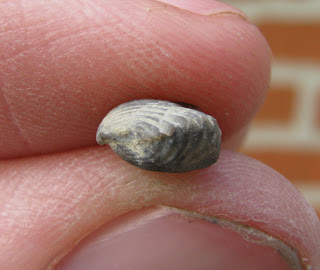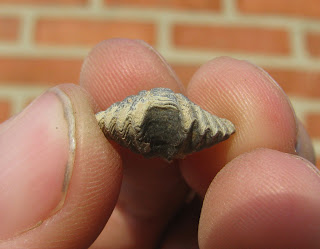While at a quarry near Napoleon, Indiana looking for fossils in the Waldron shale, I had the opportunity to collect fossils from near the Ordovician/Silurian boundary. The quarry was generally mining the Dolomite of the Silurian aged Salamore Dolomite and Brassfield Limestone (Llandovery to Wenlock series) but at the very bottom they had dug drainage ditches into the uppermost Whitewater Formation (sometimes referred to as the Saluda Fm. depending on who your talking too) which is the latest Ordovician (Hirnantian stage, Richmondian local stage). The spoils from this trench yielded a number of brachiopods of the genera Vinlandostrophia (Platystrophia of old). I'm not entirely sure of the species, since there is wide variations and one needs to account for immature individuals as well, but I believe these could be called Vinlandostrophia clarkvillensis.
Specimen #1
Pedicle valve
Anterior
Brachial valve
Posterior
Profile
Specimen #2
Pedicle valve
Anterior
Brachial valve
Posterior
Profile
Note the variation between the two specimens above, are they different species or a single species with variable shell geometry? My friend Herb states that these are Vinlandostrophia ponderosa and that these represent immature individuals. They never got any larger before they died or possibly the paleoenvironment did not allow them enough food and materials to construct the typically larger and more robust shells.
Platystrophia was renamed Vinlandostrophia in 2007 in a paper by Michael A. Zuykov and David A. T. Harper that can be found here.
I based my analysis of the stratigraphy within the quarry on the paper "Compendium of Rock-Unit Stratigraphy in Indiana" by Shaver, Robert H.; Burger, Anne M. published in 1970 by the Indiana Geological Survey. The paper is available from this page (scroll to the very bottom to download the .pdf file).
Wednesday, November 30, 2011
Monday, November 28, 2011
Trilobite bits from Lockport, NY
As I search the eroded talus of the Irondequoit limestone Rochester Shale, I sometimes find bits and pieces of Trilobites. So far it isn't even a whole pygidium or cephalon rather it's partials that are still in matrix and have been subjected to weathering.
I think that these three pieces are partial pygidiums from Dalmanites. The first piece is the most telling with a bit of the "tail" portion that sticks off the end of the pygidium. A whole specimen from the Rochester shale can be seen here.
This bit is missing the tail but has the same look as that of the specimen above.
While the first two were looking at the shell from below, this is looking at it from above. Again the pattern of the central axis and the pleural lobes on each side (what remains thereof) point to it once belonging to a Dalmanites.
This next bit is more mysterious. It's a single segment of the thorax called a pleura. The picture below is looking at the side of the specimen.
This picture is looking at the top of the specimen. Based on the known species from the Rochester shale I would guess that this could have been a part of a Bumastus or possibly a Trimerus.
TheIrondequoit limestone Rochester Shale is Silurian in age (Shienwodian stage). All the above specimens were found near Lockport, NY.
I think that these three pieces are partial pygidiums from Dalmanites. The first piece is the most telling with a bit of the "tail" portion that sticks off the end of the pygidium. A whole specimen from the Rochester shale can be seen here.
This bit is missing the tail but has the same look as that of the specimen above.
While the first two were looking at the shell from below, this is looking at it from above. Again the pattern of the central axis and the pleural lobes on each side (what remains thereof) point to it once belonging to a Dalmanites.
This next bit is more mysterious. It's a single segment of the thorax called a pleura. The picture below is looking at the side of the specimen.
This picture is looking at the top of the specimen. Based on the known species from the Rochester shale I would guess that this could have been a part of a Bumastus or possibly a Trimerus.
The
Saturday, November 26, 2011
Camarotoechia from Lockport, NY
Sorting through my findings from Lockport, NY I found a number of small Rhynchonelliids that I believe are Camarotoechia sp. The specimen below is typical of what I found.
Pedicle valve
Anterior
Brachial valve
Posterior
Profile
The specimen above was found in theIrondequoit limestone Rochester Shale which is Silurian (Sheinwoodian stage) in age. I've featured Camarotoechia before from the Middle Devonian aged Widder formation here.
Pedicle valve
Anterior
Brachial valve
Posterior
Profile
The specimen above was found in the
Thursday, November 24, 2011
Striispirifer niagarensis from Lockport, NY
One of the larger brachiopods found in the Irondequoit limestone Rochester Shale is Striispirifer. I haven't found too many whole specimens but the one shown below retains the form and shape.
Pedicle valve
Anterior
Brachial valve
Posterior
Profile
Striispirifer is in the same family of brachiopods as Eospirifer and you can see in the pic below minute striations on the shell that are reminiscent of Eospirifer radiatus. The difference between the two is that Eospirifer radiatus has a larger interarea between the posterior of it's valves and Striispirifer has prominent folds radiating from the hinge line.
Here is another specimen that is still encased in rock. The fine radiating lines on the shell are very nicely displayed.
Based on the image at the NY Paleontology website, I'm calling this Striispirifer niagarensis. TheIrondequoit limestone Rochester Shale is middle Silurian in age (Wenlock series, Sheinwoodian stage).
Pedicle valve
Anterior
Brachial valve
Posterior
Profile
Striispirifer is in the same family of brachiopods as Eospirifer and you can see in the pic below minute striations on the shell that are reminiscent of Eospirifer radiatus. The difference between the two is that Eospirifer radiatus has a larger interarea between the posterior of it's valves and Striispirifer has prominent folds radiating from the hinge line.
Here is another specimen that is still encased in rock. The fine radiating lines on the shell are very nicely displayed.
Based on the image at the NY Paleontology website, I'm calling this Striispirifer niagarensis. The
Tuesday, November 22, 2011
Favosites parasiticus from Lockport, NY
The only other coral that I've found in the Irondequoit limestone Rochester Shale is a species of Favosites. Trying to discern different species of this very common coral can be difficult. However based on the corals shown on the NY Paleontolgy website, and the Primitive Worlds website I think it is safe to say that the corals pictured below are Favosites parasiticus.
One of the features I notice is the relatively large cells , or individual calices, and fairly random growth pattern.
Specimen 1
Specimen 2
Specimen 3 - The first picture of this specimen shows the underside of the coral and you can see that it colonized a piece of a Bryozoan.
All the specimens pictured above came from theIrondequoit limestone Rochester Shale near Lockport, NY. The Irondequoit limestone Rochester Shale is middle Silurian in age (Sheinwoodian stage) and lies within the Clinton Group.
One of the features I notice is the relatively large cells , or individual calices, and fairly random growth pattern.
Specimen 1
Specimen 2
Specimen 3 - The first picture of this specimen shows the underside of the coral and you can see that it colonized a piece of a Bryozoan.
All the specimens pictured above came from the
Labels:
Coral,
Lockport,
New York,
Rochester Shale,
Silurian
Sunday, November 20, 2011
Enterolasma calculum from Lockport, NY
The Irondequoit limestone Rochester Shale fauna, that I've found, is dominated by Bryozoans and debris from Crinoids with some Brachiopods and Trilobites thrown in for good measure. I've only found two coral species so far with one being the rugose coral Enterolasma calculum. It's a small coral with linear striations running the length of the exterior.
This specimen has 22-23 septae (the radial lines inside the calice or cup).
This specimen shows a slight curvature to near the base of the corallite. This is unusual as most specimens I have found are fairly straight.
There are also 22-23 septae in the calice of this specimen too which tells me they are the same species.
Both specimens were found in the middle Silurian (Sheinwoodian stage) aged rocks of theIrondequoit limestone Rochester Shale near Lockport, NY. I based my ID of the specimens on this page from New York Paleontolgy and this page from the Primitive Worlds website.
This specimen has 22-23 septae (the radial lines inside the calice or cup).
This specimen shows a slight curvature to near the base of the corallite. This is unusual as most specimens I have found are fairly straight.
There are also 22-23 septae in the calice of this specimen too which tells me they are the same species.
Both specimens were found in the middle Silurian (Sheinwoodian stage) aged rocks of the
Labels:
Coral,
Lockport,
New York,
Rochester Shale,
Silurian
Friday, November 18, 2011
Delthyris sulcata from Lockport, NY
Delthyris is a somewhat common brachiopod within Silurian and Devonian rocks but there are several other genera that look similar such as Kozlowskiella and Howella. The specimen below I am calling Delthyris sulcata based on the picture found on this page from the New York Paleontology website.
Pedicle valve
Anterior
Brachial valve
Posterior
Profile
The specimen above came from theIrondequoit limestone Rochester Shale near Lockport, NY. The Irondequoit limestone Rochester Shale is middle Silurian (Sheinwoodian) in age.
Pedicle valve
Anterior
Brachial valve
Posterior
Profile
The specimen above came from the
Wednesday, November 16, 2011
Atrypa reticularis from Lockport, NY
Atrypa reticularis is an ubiquitous fossil from the Silurian through the Devonian. Near Lockport, NY I found some in the Irondequoit limestone Rochester Shale. The shells are typically large but almost always flattened as though through a laundry wringer.
Here is a typical specimen with nice detail preserved but when viewed from the side it's only a millimeter or two in thickness.
The flattened nature of the shells tends to cause them to break easily so finding one this large, with only a small chip missing, is somewhat rare for the site.
TheIrondequoit limestone Rochester Shale is Silurian (Sheinwoodian) in age.
Here is a typical specimen with nice detail preserved but when viewed from the side it's only a millimeter or two in thickness.
The flattened nature of the shells tends to cause them to break easily so finding one this large, with only a small chip missing, is somewhat rare for the site.
The
Subscribe to:
Posts (Atom)


















































